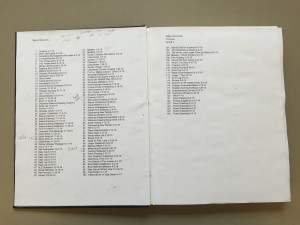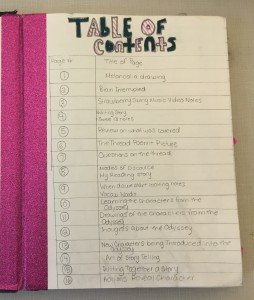“…those who fail to re-read, are obliged to read the same story everywhere” (Barthes, S/Z 16)
As we end the year I give students an opportunity to revise, add, re-work, any aspect of their journal work from the semester. And I give credit for any additional authentic work they add. All I ask is they explain what they added, where, and why. This practice gives us both an opportunity for reflection and re-reading.
When we start journals at the beginning of the year I tell the students to save the first few pages for a table of contents, to save a couple of pages at the end for lists, and to number the pages. Like the rest of us, they become busy and forget or I forget to remind them. So a few weeks before the end of the semester I ask them to work on their table of contents. This task at first seems too difficult for some, but as we talk they find ways to work. I suggest that a title for a page is like naming a poem or a movie or a chapter in a book. As they go through their journals, they are also reviewing for their Final exam. I ask questions on the exam about their journal work, so the task is a way from them to study while also creating their own view of the material we covered.
Each table of content tells a story. They find words to represent and signify. Sometimes the titles are pragmatic, sometimes poetic:
‘Making a Mark’
‘Literal/Abstract’
‘Art of Story Telling’
These tables give the students an opportunity of book-making where they are readers and writers, giving a re-reading of pages and pages of work.
In their last entry I ask the students to tell me what was their best, hardest, and most interesting work. Reading their responses gives me insight into their experience of the year. Sometimes I miss something that was valuable to them, so I can go back and have a look. Every year I catch something I missed in my first reading or the student reveals a discovery or the journal simply speaks for itself as something wonderfully made.
I had the students draw a painting and tell the story of the painting. This was a favorite for many and at the time I didn’t realize how many loved making up a story to go along with the image they had drawn.
We end the year re-reading and realizing stories abound: waiting, signifying, and inviting.
–James Shivers





I’m just stumbling on this now and I have to say I am completely enthused about visual art from pages of Shakespeare – WOW – I would love to be a fly on the wall in your classroom and better yet, be a student for a week. Those are the tasks that are meaningful, memorable, and life experiences students will draw on as they relate and connect in the real world. Do I remember my readings of 6 major Shakespeare plays in High School? No … only the Merchant of Venice where I had to memorize and perform Portia’s speech (which I still know!). Your students will remember and appreciate the pages they dissected and re-presented! Thank you for the inspiration!
Many thanks for your comments about the post. I appreciate your encouragement. I have always enjoyed works that fuse together word and image. So, I thought, why not do this in the classroom? The student responses convinced me that multimodal discourse has a vital place in the classroom. We need to keep space and time open for such creative and critical practices. I can’t wait to do the project again with this year’s students.